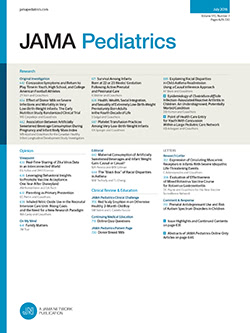多环境空气净化对儿童呼吸的益处
IF 24.7
1区 医学
Q1 PEDIATRICS
引用次数: 0
摘要
颗粒物暴露与儿童呼吸系统健康受损有关,但空气净化对呼吸系统的益处尚未得到充分阐明。目的评价多环境空气净化与假空气净化对儿童呼吸系统健康的影响。设计、环境和参与者本研究于2021年4月至12月在中国健康学龄儿童(10-12岁)中进行随机、双盲、交叉试验。数据分析时间为2021年12月至2024年7月。干预一种多环境(教室和卧室)空气净化干预与假净化进行比较,在两个阶段的干预中,每个阶段超过2个月(76天),并有一个洗脱期(88天),以估计空气净化对呼吸的好处。主要观察指标为空气净化干预前后的肺功能、气道炎症指标和呼出气凝析物(EBC)代谢物。使用线性混合效应模型来估计与空气净化有关的儿童呼吸益处。利用代谢组学分析确定了EBC中的差异代谢物,以探索它们可能的中介作用。结果共79例患儿,其中男38例[48%];平均[SD]年龄,10.3[0.5]岁)纳入统计分析。研究期间,学校场地室外细颗粒物(PM2.5)的平均(SD)浓度为32.53 (24.06)μg/m3。与假空气净化期(平均值[SD], 39.17 [14.25] μg/m3)相比,真空气净化期(平均值[SD], 21.49 [8.72] μg/m3)的时间加权个人PM2.5浓度下降了45.14%。空气净化在1秒用力呼气量提高了8.04%(95%可信区间,2.15% -13.93%),呼气流量峰值16.52%(95%可信区间,2.76% -30.28%)、用力肺活量(FVC) 5.73%(95%可信区间,0.48% -10.98%),用力呼气流量在25%到75%的FVC 17.22%(95%可信区间,3.78% -30.67%)、最大呼气流量的75% FVC, 14.60%(95%可信区间,0.35% -28.85%)、最大呼气流量的50% FVC, 17.86%(95%可信区间,3.65% -32.06%)和最大呼气流量的25% FVC 18.22%(95%可信区间,1.73% - -34.70%)。真正空气净化组呼出一氧化氮分数下降22.38% (95% CI, 2.27% ~ 42.48%)。EBC中的几种代谢物(如l -酪氨酸和β-丙氨酸)被确定介导空气净化对呼吸健康的影响。结论和相关性这项随机临床试验提供了强有力和全面的证据,证明室内空气净化可显著改善儿童肺部健康,强调了在空气污染严重的地区加强室内空气净化的重要性。临床试验注册号:NCT04835337。本文章由计算机程序翻译,如有差异,请以英文原文为准。
Respiratory Benefits of Multisetting Air Purification in Children
ImportanceParticulate matter exposure has been linked to impaired respiratory health in children, but the respiratory benefits of air purification have not been fully elucidated.ObjectivesTo assess the respiratory health outcomes among children exposed to multisetting air purification vs sham purification.Design, Setting, and ParticipantsThis cluster randomized, double-blind, crossover trial was conducted among healthy school-aged children (10-12 years) in China from April to December 2021. Data were analyzed from December 2021 to July 2024.InterventionsA multisetting (both in classrooms and bedrooms) air purification intervention compared with sham purification in a 2-stage intervention with more than 2 months (76 days) for each period and a washout period (88 days) to estimate the respiratory benefits of air purification.Main Outcomes and MeasuresThe primary outcomes were pulmonary function, airway inflammation markers, and metabolites in exhaled breath condensate (EBC) before and after the air purification intervention. Linear mixed-effects models were used to estimate the respiratory benefits of children related to air purification. Differential metabolites in EBC were identified using metabolomics analysis to explore their possible mediation roles.ResultsA total of 79 children (38 male [48%]; mean [SD] age, 10.3 [0.5] years) were included in the statistical analyses. During the study period, the mean (SD) concentration of outdoor fine particulate matter (PM2.5 ) at the school site was 32.53 (24.06) μg/m3 . The time-weighted personal PM2.5 concentration decreased by 45.14% during the true air purification period (mean [SD], 21.49 [8.72] μg/m3 ) compared with the sham air purification period (mean [SD], 39.17 [14.25] μg/m3 ). Air purification improved forced expiratory volume in 1 second by 8.04% (95% CI, 2.15%-13.93%), peak expiratory flow by 16.52% (95% CI, 2.76%-30.28%), forced vital capacity (FVC) by 5.73% (95% CI, 0.48%-10.98%), forced expiratory flow at 25% to 75% of FVC by 17.22% (95% CI, 3.78%-30.67%), maximal expiratory flow at 75% of FVC by 14.60% (95% CI, 0.35%-28.85%), maximal expiratory flow at 50% of FVC by 17.86% (95% CI, 3.65%-32.06%), and maximal expiratory flow at 25% of FVC by 18.22% (95% CI, 1.73%-34.70%). Fractional exhaled nitric oxide in the true air purification group decreased by 22.38% (95% CI, 2.27%-42.48%). Several metabolites in EBC (eg, L-tyrosine and β-alanine) were identified to mediate the effect of air purification on respiratory health.Conclusions and RelevanceThis randomized clinical trial provides robust and holistic evidence that indoor air purification notably improved pulmonary health in children, highlighting the importance of intensified indoor air purification in regions with high air pollution levels.Trial RegistrationClinicalTrials.gov Identifier: NCT04835337 .
求助全文
通过发布文献求助,成功后即可免费获取论文全文。
去求助
来源期刊

JAMA Pediatrics
PEDIATRICS-
CiteScore
31.60
自引率
1.90%
发文量
357
期刊介绍:
JAMA Pediatrics, the oldest continuously published pediatric journal in the US since 1911, is an international peer-reviewed publication and a part of the JAMA Network. Published weekly online and in 12 issues annually, it garners over 8.4 million article views and downloads yearly. All research articles become freely accessible online after 12 months without any author fees, and through the WHO's HINARI program, the online version is accessible to institutions in developing countries.
With a focus on advancing the health of infants, children, and adolescents, JAMA Pediatrics serves as a platform for discussing crucial issues and policies in child and adolescent health care. Leveraging the latest technology, it ensures timely access to information for its readers worldwide.
 求助内容:
求助内容: 应助结果提醒方式:
应助结果提醒方式:


